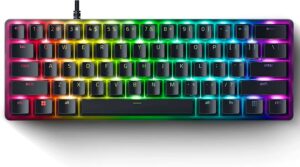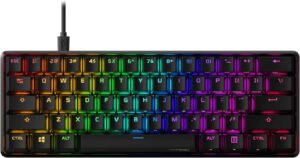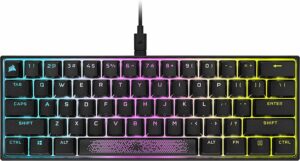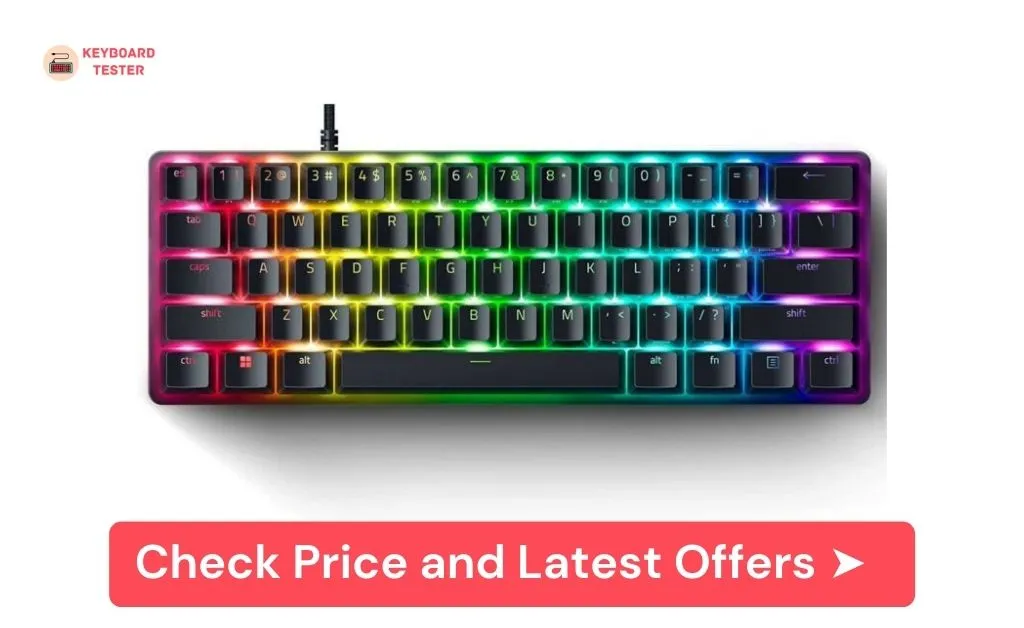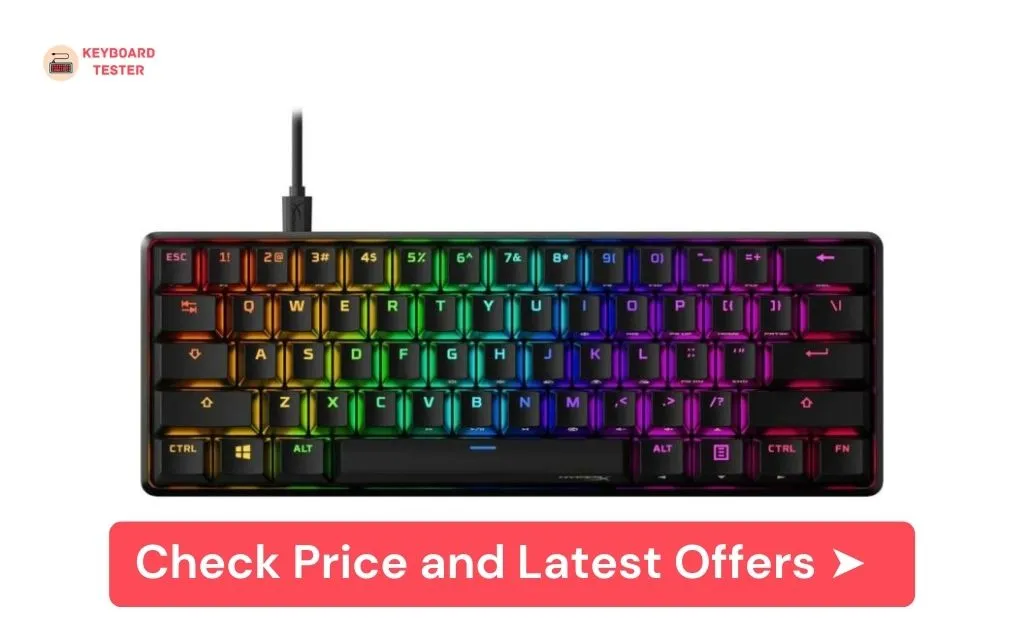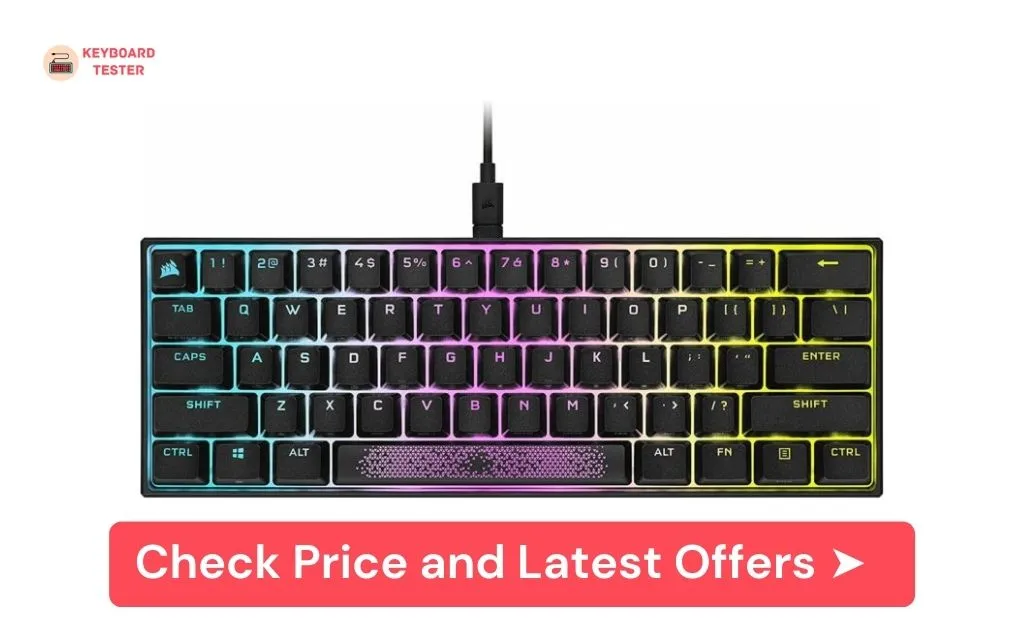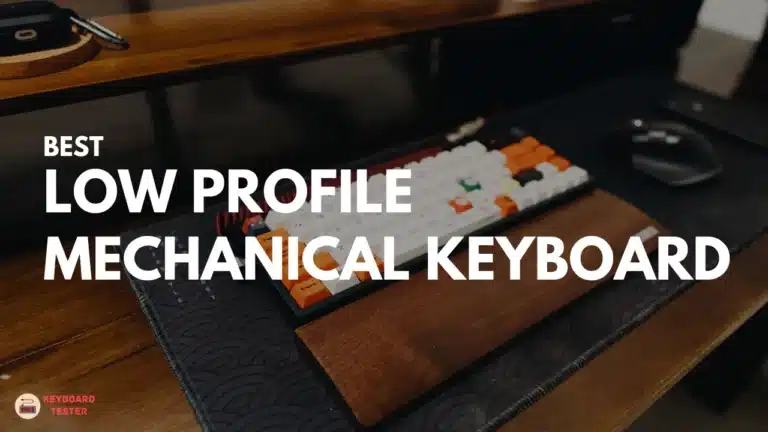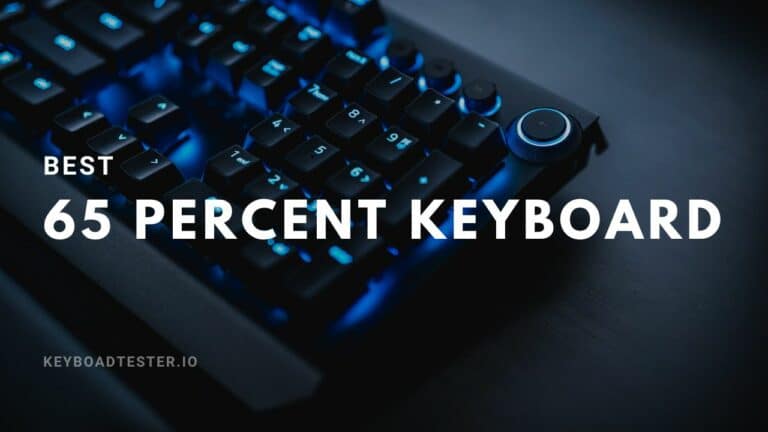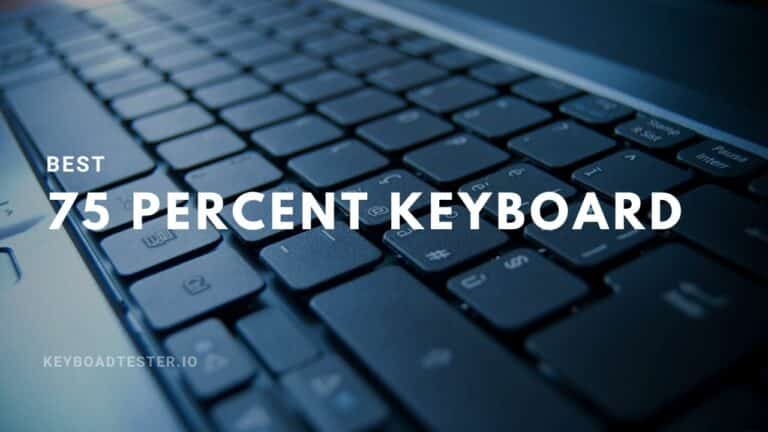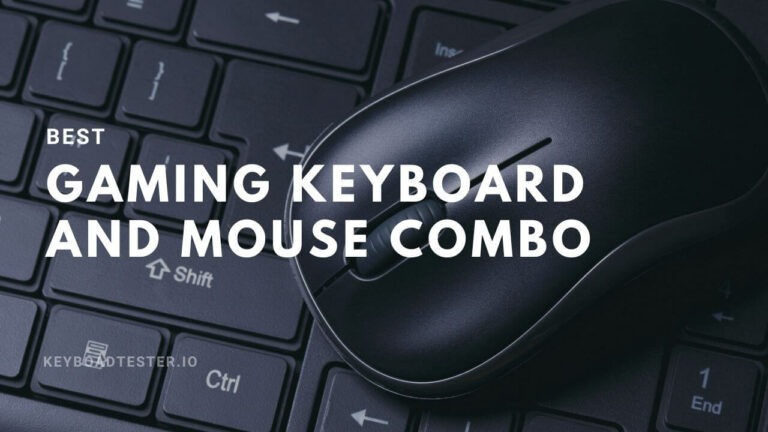Best 60 Percent Keyboard for 2023
Are you looking for a compact keyboard with sufficient room for gaming on the desk?
Well, a 60% gaming keyboard should be your choice.
We have tested more than 30 keyboards based on connectivity, build quality, battery life, and types of switches.
After our detailed analysis, we have brought the 60 percent keyboard, which will never disappoint you with its performance.
What is a 60% Keyboard?
A 60% keyboard is a compact keyboard design that typically includes only about 60-65 keys, compared to the standard 104 keys on a full-size keyboard. These keyboards omit the following:
- Number pad
- Function row (F1-F12)
- Arrow keys
- Navigation cluster (Home, End, Page Up, Page Down)
Despite these omissions, 60% keyboards retain all alphanumeric keys and most modifier keys, accessing additional functions through key combinations or layers.
Benefits of 60% Keyboards
60% keyboards offer several advantages:
- Space-saving: Their compact size frees up desk space for mouse movement or other items.
- Portability: Smaller and lighter, making them ideal for travel or mobile setups.
- Ergonomics: Reduced size allows for a more natural arm and wrist position, potentially reducing strain.
- Aesthetics: Minimalist design appeals to those seeking a clean, uncluttered look.
- Efficiency: Once mastered, the compact layout can increase typing speed and reduce hand movement.
- Customization: Many 60% keyboards offer extensive programmability and customization options.
Best 60 Percent Keyboard for 2023 – Complete List
1. Razer Huntsman Mini – Overall Best
Huntsman Mini is the best of the primary 60% keyboards now available. While I haven’t always been a fan of Razer’s optomechanical switches, I’ve seen a big improvement in this keyboard’s performance.
This keyboard is excellent for gamers who value silence and responsiveness above the springy key switches feel.
Because it is not a wireless connectivity model, you must carry around a USB-C cable whenever you use it away from home.
The Huntsman Mini gaming keyboard is also white, making blending in with your existing decor easier than many other gaming peripherals. Set the LED lights to something neutral, and you are good to go.

Why We Love This Product
- This keyboard has good software customization options with Synapse.
- It has PBT keycaps and linear switch options.
- It has an attractive design.

Why We Don’t Like This Product
- The keyboard has a loud hollow sound.
- It is extremely lightweight.
2. HyperX Alloy Origins 60
The HyperX Alloy Origins 60 is a mechanical keyboard with a metal baseboard if you’re looking for a 60 percent keyboard that’s strong and durable.
It is bulkier than competing products, so if you’re trying to minimize the weight of your suitcase, there may be better choices.
This keyboard will tolerate your forceful keystrokes even if you are an aggressive typist.
Why We Like This Product
- The keyboard comes with impressive RGB lighting.
- It includes a keycap puller
- It has a compact footprint
Why We Don’t Like This Product
- The keyboard does not come with a wireless option.
3. Corsair K65 RGB Minimalist design
The K65 RGB Mini is not necessarily one of the best keyboards the company has ever produced but worth the price.
The plastic casing seemed hollow, and the keys rang when struck.
Users already invested in Corsair’s iCUE software may keep their accessories under one customizing suite rather than switching between interfaces.
If you do not care about this, the HyperX Alloy Origin 60 is superior and a better choice.
Why We Love This Product
- The design of this compact 60% keyboard feels natural
- It supports a detachable USB-C cable
- The space bar has a cool fractal design
Why We Don’t Like This Product
- It lacks strong differentiating features
- The 8000 Hz polling of this keyboard is not helpful
4. Anne pro 2
Anne Pro 2 achieves the impossible by providing an affordable enthusiast 60 keyboard. It has robust features and offers a pleasant typing experience.
It provides wired and Bluetooth wireless connectivity for less than $100.
Additionally, it offers the flexibility to switch between four multiple devices in wireless mode.
Through the intuitive ObinsKit software, you can tweak key inputs, modify wireless settings, program key backlighting, and even generate custom commands.
Why We Love This Product
- It’s a fantastic keyboard with better software customization
- It comes with great switch options
- It supports a wireless connection
Why We Don’t Like This Product
- RGB light is dim and inconsistent
- The wireless connectivity of this keyboard is unreliable
How Many Keys Does A 60% Keyboard Contain?
It is important to note that gaming keyboards often adhere to one of three configurations.
The most typical type is the full-size deck, which typically has between 100 and 110 keys, based on whether the maker adds media buttons or macro keys.
Every keyboard has a number pad to the far right and a function row along the top.
Most gamers will choose a full-size keyboard over a compact one since it enables them to perform several operations with a single press and program macros for actions that aren’t built into the keyboard.
Keyboards without the right-most number pad, known as “tenkeyless decks,” have been popular for some time.
Although they are slimmer because 17 keys were removed, they still include the keys you need to access the media controls and do other functions.
Sure, it has more than 10 keys, but “seventeenkeyless” doesn’t sound as good. When gamers require an extra room on their workstation and don’t need a rapid means to enter numbers or perform computations, they may opt for one.
Then there are 60 percent keyboards, which, as its name suggests, remove 40 percent of the keys from a regular keyboard, leaving only 61.
In addition to removing the number pad, the function keys, arrow keys, and occasionally helpful system keys such as “print screen” and “home” are also eliminated. On some systems, they are inoperable.
On a 60 percent keyboard, you’ll use the function key to access these controls; as there’s no universal design for gaming keyboards, switching brands like Razer, HyperX, or Corsair will require you to memorize an entirely new set of shortcut keys.
Additionally, they lack built-in wrist supports, but the height is adjustable. Few models also offer Bluetooth connectivity.
New from Razer is a 66% keyboard, a less typical keyboard layout that retains the arrow keys and other functions while discarding the rest to keep a slimmer profile.
This is the best choice if you frequently use the arrow keys. As a text editor, I rely on them frequently, in some games, they may replace the more familiar WASD keys.
Advantages Of A 60 Percent Keyboard
Why get a 60 percent keyboard if so many functionalities are missing? The only purpose of utilizing a tiny keyboard is, of course, to save room.
It’s good not to have to cram yourself into a tiny space to play a video game or, like me, move a bunch of junk off your desk so you can move around.
Particularly useful if you like to eat while working. The compact design doesn’t get in your way when you need to set down a bowl or plate.
The fact that I can shake crumbs off the keyboard with one hand makes the keyboard much cleaner.
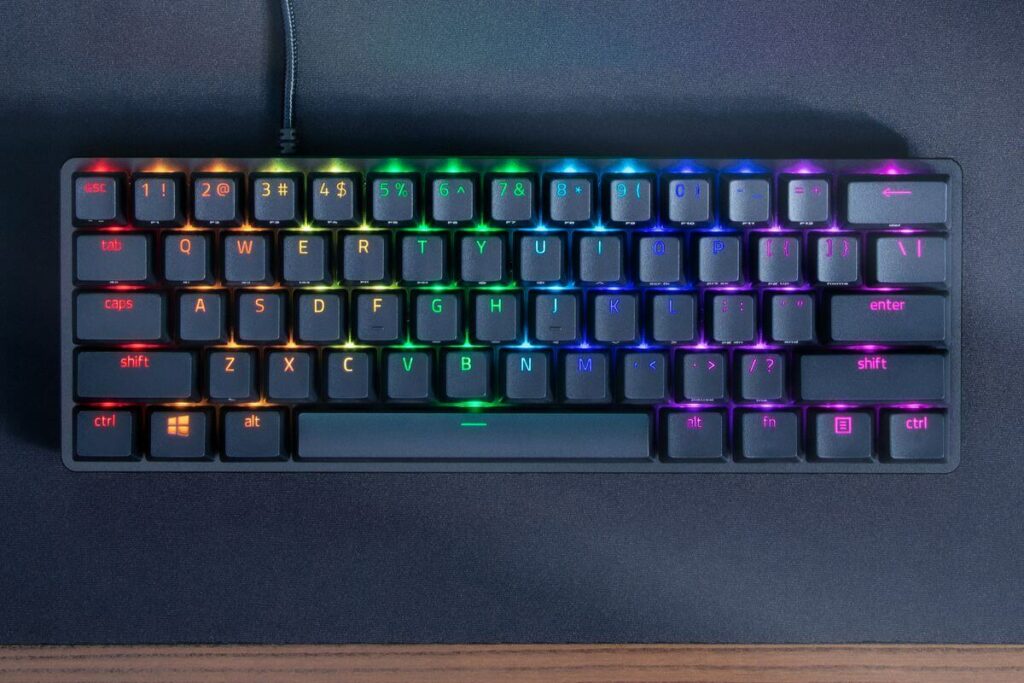
Being 60 percent smaller than a laptop keyboard, it takes up less room in your backpack than a laptop, albeit it’s still a bit thick, evidently making it more portable.
Mechanical keyboards feature lower-profile keys than regular decks, but if portability is your primary issue, you’re generally better off with a standard deck.
The most recent 60% and 65% decks have wired keyboards with removable USB-C cables, a huge feature often overlooked.
Leave a cord for your keyboard at each location to save time moving from desk to desk.
As a person who tests many keyboards, I find this useful because I can swap out the deck while leaving the wire intact.
Whenever I test a new keyboard, I must remove cords and detangle them from my office setup, which can be a major nuisance. However, I’ve used the same wire for 60 percent of the models.
Key Features to Consider
Connectivity Options
When choosing a 60% keyboard, consider the following connectivity options:
- USB-C: Offers fast, reliable wired connection and often supports charging for wireless models.
- Bluetooth: Enables wireless connectivity with multiple devices, ideal for use with tablets or smartphones.
- 2.4GHz wireless: Provides low-latency wireless connection, typically via a USB dongle, suitable for gaming.
Some keyboards offer multiple connectivity options, allowing for greater versatility.
Build Quality and Durability
A high-quality 60% keyboard should feature:
- Sturdy construction: Look for keyboards with metal or high-grade plastic cases for longevity.
- Durable keycaps: PBT keycaps are preferred for their resistance to wear and shine.
- Quality switches: Mechanical switches from reputable manufacturers ensure long-lasting performance.
Durability is crucial for a keyboard that can withstand frequent use and potential travel.
Software Customization
Many 60% keyboards offer software for extensive customization:
- Key remapping: Allows users to reassign key functions for personalized layouts.
- Macro programming: Enables creation of complex commands assigned to single keystrokes.
- Backlighting control: Customizable RGB lighting for aesthetics and functional key highlighting.
- Profile management: Ability to save multiple configurations for different use cases.
What To Consider Before Purchasing A 60-Percent Keyboard?
Adjusting to a slim keyboard design can feel like a big change if you’re used to using a full-size or even TKL keyboard.
Choosing one is like any other type, so long as you’re prepared to jump. Before purchasing a new keyboard, we consider the following factors:
Choosing the Right 60% Keyboard
Assessing Your Needs
When selecting a 60% keyboard, consider the following:
- Typing habits: Evaluate how often you use function keys, arrow keys, and the numpad.
- Primary use: Determine if it’s for gaming, programming, general typing, or a mix.
- Workspace: Consider your desk space and portability requirements.
- Customization preferences: Decide if you want to modify keycaps or switches frequently.
Adaptation Period
Switching to a 60% keyboard involves a learning curve:
- Expect an initial decrease in typing speed and efficiency.
- Plan for 1-2 weeks of adjustment to the new layout and key combinations.
- Practice using function layers and shortcuts to access missing keys.
- Consider starting with a programmable 60% keyboard for easier customization.
Price Considerations
60% keyboards vary widely in price:
- Entry-level models start around $50-$100.
- Mid-range options typically fall between $100-$200.
- High-end custom or premium 60% keyboards can exceed $300.
Factors influencing cost include:
- Build quality and materials used
- Switch type and quality
- Keycap material and design
- Additional features like wireless connectivity or hot-swappable switches
Which Keys Are Indispensable?
There is a wide variety of keyboard sizes.
Full-size keyboards (104+ keys), tenkeyless keyboards (approximately 87 keys), 65 percent keyboards (67-70 keys), and 60 percent keyboards (60 keys or fewer) are the most commonly used sizes (62-65 keys).
As keyboards become smaller, more keys are lost, including some frequently used ones.
Keyboards with only 60% of the standard layout typically need the number pad, function row, arrow keys, and other keys like home and delete. There are benefits and drawbacks to using a compact keyboard.
On the plus side, the keyboard occupies less room. On the downside, you’ll have to rely more on shortcuts and hotkeys to accomplish the same things that would be easier to reach with a full-sized keyboard.
Think long and hard about how you use your keyboard daily before making the transition to see if the new layout will streamline your life or add unnecessary friction to your typing routine.
There Is A Brief Phase Of Adaptation
The layout shifts as well, with the 60% and 65% keyboards becoming one continuous block of keys with no extra space between them.
Users should anticipate a little learning curve when switching to a smaller keyboard due to the omission of some keys, the introduction of shortcuts, and the redesign of the physical layout.
This does not mean that users will suddenly forget how to type, but they can anticipate typing more slowly and making more typos during the first two weeks of using a smaller keyboard.
Wireless Or Hardwired?
A wireless keyboard is a practical method to declutter and offer yourself more freedom in placing your keyboard for most of your daily computing (and yourself).
However, you may prefer a wired keyboard if you use your computer for gaming or content creation.
Numerous wireless keyboards, particularly those that connect over Bluetooth, introduce a tiny bit of input latency.
The term “latency” refers to the time it takes from when you push a button or key until the action you pressed that button or key for actually takes place.
Using a Bluetooth keyboard, you probably won’t experience any perceptible lag when typing.
This becomes a problem while playing games or performing any activity that demands accurate timing. But for gamers? Any delay can determine the outcome of a contest.
Using a 2.4GHz connection and wireless USB dongle, game manufacturers have developed an alternative wireless technology.
This connection is a must-have if you’re purchasing a wireless gaming keyboard. The most steady and reliable connection is still cable. Additionally, wireless mechanical keyboards typically cost more than their cable counterparts.
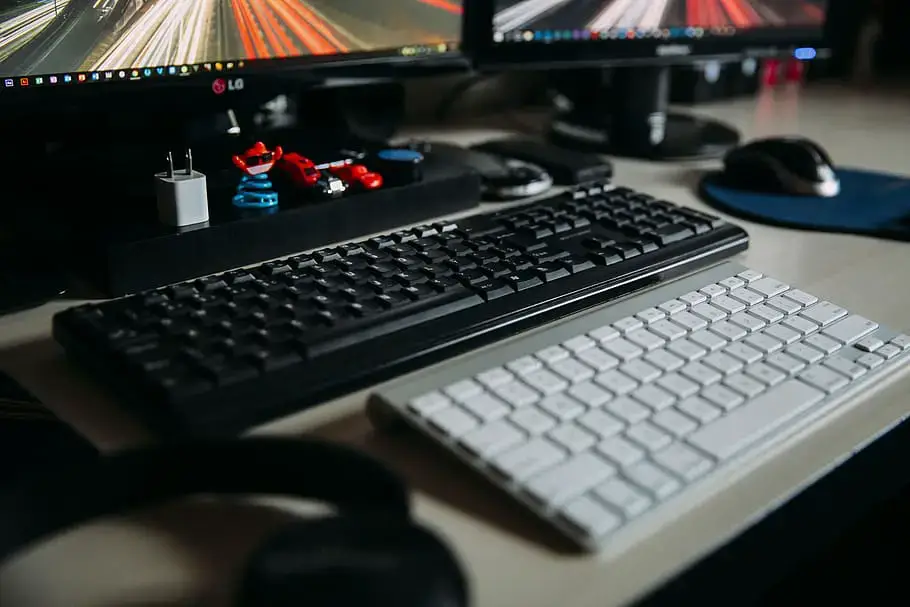
How Do You Want The Feel And Sound Of Your Keyboard To Be?
Unlike most laptops or cheap keyboards, most keyboards (60 percent) have mechanical key switches.
Mechanical switches contain spring-loaded mechanisms behind each keycap that cause the input, unlike the keys on a laptop or slimline keyboard. They have a distinct tone when pressed and offer better tactile feedback.
There are numerous varieties of key switches, ranging from loud “clicky” switches to sleek “linear” ones.
The key switch’s choice significantly impacts a keyboard’s feel and sound.
You may find additional information regarding key switches in our guide to the finest mechanical keyboards or on enthusiast websites such as Mechanical Keyboards.
Frequently Ask Questions
Ques: What is a sixty percent keyboard?
Ans: A 60 percent keyboard, as its name suggests, has 62 keys rather than the full-sized keyboard’s 104. Smaller keyboards generally lack a number pad, a row of function keys, and arrow keys.
It’s one of the most compact, lightweight, and ergonomically sound pre-built keyboards.
Ques: What is the price of a 60 percent keyboard?
Ans: 60 percent of keyboards typically cost less than bigger keyboards due to their size, although not significantly. Popular 60 percent keyboards, such as the Royal Kludge RK61, are available for as little as $50.
The majority of our best small keyboards cost approximately $100. The prices of 60% and 65% of keyboards are similar.
Ques: Are 60% of keyboards suitable for everyday use?
Ans: Many people find keyboards with a 60 percent key travel ideal for daily use.
A 60% keyboard can be more convenient if you have limited desk space, rarely use the number pad, and don’t need access to the function keys.
Ques: Why do gamers utilize 60% of keyboards?
Ans: Gamers, especially competitive players, like tiny keyboards since they are simpler to angle while playing.
Making room for your mouse by tilting the keyboard toward your non-dominant hand decreases wrist movement and makes it easier to utilize the mouse. Browse our list of the best gaming keyboards for additional details.
Ques: Which keyboard’s 60 percent shifts are the quickest?
Ans: As many keyboards have numerous switch types, no single keyboard has the fastest switches. In general, linear key switches, like Cherry MX Reds, have a “faster” sensation since they require less force to activate.
Ques: Are keyboards with 60% more keys superior?
Ans: Keyboards with a width of 60% are not inherently superior to those with a width of different percentages. Some favor 60% of keyboards due to their compact size and simplistic design.
Others want full-sized keyboards with the most key options. Others like TKL models as a compromise between the two.
Because everyone has unique keyboard preferences, we’ve created numerous tips on the finest keyboards.
Conclusions
Typists and gamers wanting a more compact and ergonomic experience may find the top 60% of keyboards ideal.
Those without a numeric keypad, function, and arrow keys can explore this streamlined and simple typing method.
For everyone else, we recommend a variety of larger keyboards, including the most ergonomic keyboards for those with hand and wrist problems.

